Long before rice water went viral on TikTok and YouTube and ended up on Kardashian blogs, the beauty practice had been used for centuries by women in Asia. According to research published in the Journal of Cosmetic Chemists, court ladies during Japan’s Heian Period (794 to 1185 CE) used Yu-Su-Ru (a.k.a leftover water from washing rice) on their floor-length hair.
The method was then popularized by a village in China called Huangluo. The Yao women, who inhabit the town, are famous for their long hair that averages six feet long. According to Medical News Today, the Yao women credit their strong strands and dark color to washing it in rice water.
While most of rice water’s proof of effectiveness is limited to history and tradition, there is scientific reasoning behind its benefits.
To dive into this further, ELLE.com tapped two hair pros, Dr. Jenny Liu, a board-certified dermatologist, and Richy Kandasamy, a colorist and R+Co Collective Member, to explain the benefits of rice water—plus how you can create rice water at home.
What are the benefits of rice water for hair?
Will rice water turn you into Rapunzel? Not exactly. But it does have properties that restore and promote hair growth. “Scientifically, 18 amino acids have to come together to create the protein to grow hair. Rice water contains eight of these amino acids,” Kandasamy explains. “So when rice water is used on hair, you experience more hair regeneration. The vitamins in rice water (B, C, and E) also boost hair growth. Though there is limited scientific evidence that proves hair growth.”
Dr. Liu echoes the importance of these acids. “We have limited studies, but few out of Korea demonstrate it may help with male pattern hair loss,” she adds. “Rice bran, in particular, has lots of fatty acids—linoleic acid and oleic acid that have been proposed to possibly inhibit the 5-α-reductase enzyme that is the cause of male pattern hair loss.”
How do I make rice water?
Washing your hair with rice water is easy to achieve at home. All you need is one cup of uncooked rice, a large jar or bowl, and a filter.
- Put water in a bowl and use a strainer to rinse your rice. You want to make sure all impurities are removed from the grains. Some videos suggest rinsing multiple times, until the water runs clear.
- Fill your jar or bowl with one cup of water and add the clean rice. Stir the rice in the bowl. If you have a jar, you can secure the lid and shake the rice. The water should look milky.
- Let the mixture rest for 24 hours.
- After 24 hours, strain the liquid from the rice. Store the liquid in a jar, empty shampoo bottle, or container.
This content is imported from YouTube. You may be able to find the same content in another format, or you may be able to find more information, at their web site.
How do I apply rice water?
Treat rice water like your typical hair mask or treatment. “First, you should wet your hair with the rice water, especially your scalp area, and massage it for five minutes,” Kandasamy says. “This step targets your follicles, which stimulates growth and strengthens your hair.”
Wait five minutes and wash the rice water out using your favorite shampoo.
Is rice water safe for all hair types?
The short answer is: yes. Rice water will work on different hair types but consider your hair porosity before using. “All hair types are the same structurally, including African, European, and Asian hair types, but all absorb moisture in different ways,” Kandasamy explains. “It is rich in amino acids which strengthen hair roots, add shine and make it smooth and silky. It also contains a carbohydrate known as inositol, which repairs damaged hair and protects hair from further damage. Since it is a natural remedy, it is safe, and there are no side effects of rice water on hair.”
Hair provides more room for experimentation and trial than our skin. “In general, I would say yes, [rice water is safe for all hair types]. It’s not like moisturizers where greasy moisturizers are less ideal for oily skin,” adds Dr. Liu.
This content is created and maintained by a third party, and imported onto this page to help users provide their email addresses. You may be able to find more information about this and similar content at piano.io
